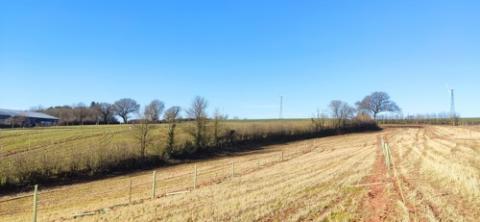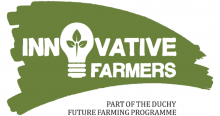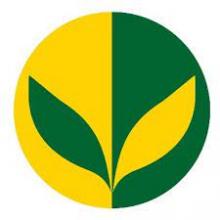The trial has been designed to explore the commercial and environmental effects of implementing silvopasture on UK farms. The farmers have been supplied with trees and planting advise by The Woodland Trust. Each farm has planted one or more of the three silvopasture designs with the long-term goal of establishing an agroforestry system for the livestock on their farm. Over 12-years, the trial will explore the impact on economic performance, biodiversity, soil health, soil carbon and animal welfare, to name just a few.
We caught up with three participants from the field lab at The Agroforestry Show in September 2023.
Andy Gray farms at Elston Farm on light, loamy red soils where he has a meat business, dog food business, and farms livestock and cereals. You can hear more about Andy’s farm and why he’s getting involved in the silvopasture network in a short film here.
Rob Dunn is a postdoctoral researcher at Rothamsted Research based at North Wyke Farm. Rothamsted mostly does pastoral research and has been conducting agroforestry trials on their heavy clay soils since the 1980s. You can hear more about Rob’s story and why Rothamsted are getting involved in these trials in a short film here.
Henry Andrews farms suckler beef on heavy clay grassland near Holsworthy. After witnessing first-hand how much happier his cows were in an agroforestry system, he embarked on the trial with the hope of further positive gains from implementing silvopasture.
You can find out more about the triallists through a series of short films on the research, kindly funded by Rothamsted Research centre.
The early benefits of silvopasture
Andy, Rob and Henry are all working with varying, individual soil types and have their unique reasons for establishing silvopasture. It may take some years for established research to come out of the trials, but in the short 2.5 years since the start of the field lab, many of the farmers and the team at Rothamsted have already seen positive outcomes from planting trees on-farm.
Andy’s planting design includes a mantle of three hawthorns around the trees that has grown into a protective hedge. In 2021, these hawthorns were nine inches high – they’re now at five feet and already providing protection. Having thought it would take 12 years before he could put livestock in those fields, he now thinks they will be summer stocking in those areas in five years’ time. He shared that he thinks that “it will be a more profitable system. We can have our cake and eat it – we can help nature; we can capture carbon and we can produce more meat. My ambition is to turn trees into meat and I’m sure it’ll work”.
Tests for time-poor farmers
Andy received a UKRI grant to conduct this research and has primarily been looking into insects, bats and dung beetles. AI cameras are being used to track and label insects – the camera takes a photograph and assigns the insect a number or name which allows it to be tracked and data to be attached to it. The more data it collects, the more intelligent it becomes in learning more about the insects. Baseline assessments have been taken before the trees were planted, which will be compared to later findings to see how the trees impact biodiversity. The key thing about these cameras is that they can run continuously with little need for farmer input after installation. This helps build data which fits around the practical needs of the farm.
Base line soil mapping
At Rothamsted, thousands of soil samples were taken across the site before the trees were planted. The team have mapped the location of each of the 9,500 trees planted for the silvopasture research to be able to make an association between soil carbon and each tree species.
Farmer observations on the benefits of silvopasture
On Henry’s farm, much of the impact has been observational so far, as he commented, “My main interest is research into cattle welfare – weight gain, how grazing between and on trees can help them. In the last two years we’ve only used antibiotics once and we’ve found that grazing the willows has helped with lameness. We had a nice old coppice that the cows grazed, and I realised how happy they were - when I came into the field, they perked their ears up and were alert, but they didn’t mind me as they were browsing the trees”.
Henry also shared that with cows grazing in coppice they have seen less worm egg counts in their stool, which they have measured against stock grazing on open pasture. The decrease has been so significant that they have stopped worming cattle that are among the trees and have hardly found any worm burdens. Additionally, when weighing the cattle each month, they saw day live weight gains hadn’t dropped off from not being on open pasture – it is suggested that this could be due to the high protein content of leaves, as well as cows being able to graze mulberries and similar wild fruits.
The early challenges
Establishing trees in an agroforestry system
Unpredictable weather made the early establishment stage of the trial more challenging. From multiple destructive storms to a long period of drought in 2022 and earlier in 2023, followed by exceptional rainfall. During this process there were clearly a lot of learnings around getting tree establishment right, as well as how to control grass around the trees.
Andy’s main advice is to have as young and small a tree as you possibly can and make sure that you guard it adequately, as he shared that “the smaller the tree you plant, the faster it grows and more rapidly it overtakes the more expensive, bigger trees”. He planted his trees using a satellite-navigated tractor with three subsoil links on the back to create lines that gave exact 14m rows. He then had 60 volunteers help plant the 8,500 trees, which took two weeks.
At Rothamsted, the 2,500 trees were planted manually with the help of employees over two weeks. They scarified the ground, put a ‘v’ slot in and planted bare root trees in with a stake and tree guard. The trees at Rothamsted had a 97% survival rate in the first year. As more research is done on the other farms, there will be further data on survival rates across all seven sites.
Henry similarly planted trees manually. All of the farmers experienced a high number of broken tree stakes due to bad weather. Having been on a tight budget, Henry chose cheaper stakes and found that a lot of them broke. To save hassle and time, investing in high-quality stakes is strongly advised by all of the participants. The taller tree guards – around 1.8m – provide better protection, over the smaller spiral guards that can be easily browsed off by deer. Henry added that they found that it was a lot harder to re-stake easily in the shelterbelt design in comparison to the alleys.
Grass control in an agroforestry system
A competitor to be wary of when planting trees is grass, as it is hungry for moisture and nutrients. Henry, Rob and Andy all sprayed round-up around the base of some of their trees to suppress grass growth. Rob only did this during the first summer but did not continue into following years and simply left the trees to their own devices. Andy contributes some of the success of the establishment of his trees to using round-up for two years.
In contrast, Carolyn – another farmer on the trial – did not use round-up at all and her trees have established very well. Henry did a mix of mulching some, using round-up on others and leaving many alone. Additionally, on the alleys at Henry’s farm, they have put electric fencing half a metre away from the trees with the bottom strand at knee height – due to this, they’ve found that the cows help quite a lot with grass suppression.
The future of this research
Simeon Day – a FWAG South West adviser on hedgerows, traditional orchards, agroforestry and trees outside of woodlands – is currently undertaking surveys gathering data on the establishment process and outcomes from each of the farms. FWAG SW are also using an app – Quick Capture – to collect data on every single tree planted to map whether it’s alive or dead, what the tree species is and add GPS location tracking to it. This will give an overall indication of how well the trees have established and enable the researchers to follow the development of each tree as the trial progresses. This data should be available in November and will be uploaded to ArcGIS and Land App so that anyone can access it. This kind of technology can be used by anyone to map your own trees on-farm and collate similar data – Simeon also recommends Survey123 as another easy-to-use app to collect this kind of data.
While this research is only in its infancy, there has already been a great deal of learnings. In the next few years, more samples will be taken to test soil health, biodiversity, and animal welfare, among other metrics. These samples will be compared with the original baseline samples and should hopefully show some very interesting data that will enable the Devon Silvopasture Network to start building a more solid picture of the real impact that silvopasture is having on their whole farm systems.




